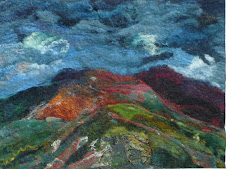


Dot Lumb in her blog Fibre 2 Fabric mentioned the state of her studio saying that the place that had been immaculate two years ago was now almost too full to move in. It set me thinking about my studio. One fellow artist just says "Oh my God" whenever he sees it Early on in the week I taught 7 people Felt Beyond the Boundaries-incidentally one of favourite workshops- in a beautiful pottery studio ( Ceri Pottery) high in the hills near Newtown in Powys. Her large studio with two pottery wheels and lots of working space was immaculate and really put mine to shame. My worse enemy could not describe mine as immaculate and here it is in all its organised chaos glory with photos from the doors at either end. This is what the BBC saw when they came interested in running a children programme .
I thought it would be fascinating to have a show of working places. What does your studio look like?
Mine I realise is going to have a face lift before the Open Studio event later this year Helfa Gelf. sigh.When?I don't know and where will everything go while I wash down the walls and paint? I know it needs to be done and I will feel better for it but ..............................arrgh!































